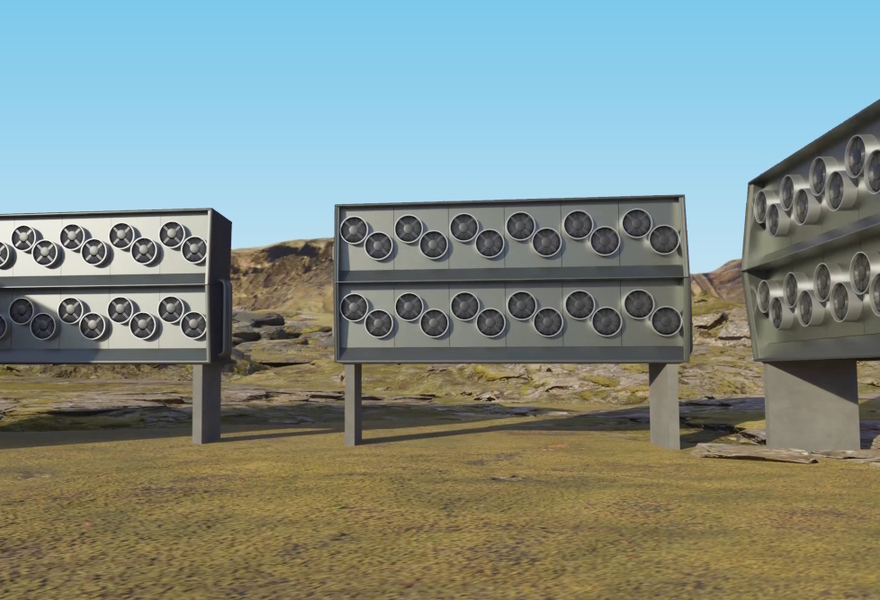Carbon removal technologies: two new studies inform outlook on scaling
Climate scenarios require rapid development of novel methods. The speed is in line with developments in the past. Company and government announcements imply faster growth.

Air filters: Pilot plant for carbon dioxide removal using the innovative “Direct Air Capture” method in Iceland. | Photo: Climeworks
In the run-up to the UN Climate Change Conference beginning on November 30, one lingering question is whether climate technology is developing and scaling quickly enough: to meet the Paris Agreement’s goal of limiting global heating to below 2 and possibly 1.5 degrees Celsius. Two new studies can help inform discussions around the scaling of carbon dioxide removal technologies. Being co-authored by the Berlin-based climate research institute MCC (Mercator Research Institute on Global Commons and Climate Change), and led by the University of Wisconsin-Madison, they have been published in renowned journals: one in Communications Earth & Environment, and one in Joule.
According to the Communications Earth & Environment study, the rate of development for carbon removal technologies that could be critical tools to combat climate crisis is in line with similar developments over the last century. The research team debut the “Historical Adoption of TeCHnology” (HATCH) dataset – an innovative project that tracks and analyses a variety of agricultural, industrial, and consumer technologies adopted in the past. The project can provide insight into the scale-up of new technologies such as carbon removal from the atmosphere.
The study analyses the emergence and growth of 148 technologies across 11 categories going back to the early 20th century. It cross-references this data with model carbon removal scenarios established by the Intergovernmental Panel on Climate Change (IPCC), company announcements of relevant scale-up plans, and removal targets in policy announcements. While the paper finds evidence that the required scale-up of relevant technologies according to the scenarios fits within the historical range of previous efforts, company announcements and government targets imply much faster growth than the historical record.
The Joule study also deals with the outlook on scaling. It finds that to meet the Paris Agreement’s goal, novel removal methods need to scale at a much faster rate than to date. Achieving this goal would require the removal of hundreds of gigatonnes of carbon dioxide from the atmosphere over the course of the century. Examples of conventional methods include reforestation, wetland restoration and improved forest management. All other methods have only been deployed at small scale and are collectively known as “novel CDR” (for carbon dioxide removal). Examples include large air filter systems (“Direct Air Capture”), the combination of climate plantations and biomass power plants with capture and underground sequestration of CO2, as well as storage of CO2 in biochar. The study finds that about 2 gigatonnes of carbon dioxide removal per year is taking place currently, with nearly all of it from forestry and only 0.1 percent from novel CDR. But virtually all scenarios that limit global heating to 1.5 or 2 degrees Celsius require novel CDR: on average, they require an increase by a factor of 1,300 by mid-century.
The research team looks at the formative phase of technologies, i.e. between first commercialisation and rapid scale-up. “To become climate relevant, the formative phases for air filter systems and other novel methods of carbon removal need to be at least as active as the fastest historical analogues,” says Jan Minx, head of the MCC working group Applied Sustainability Science and a co-author of both studies. “This will require more serious commitments toward these technologies than are currently in place. The required levels will only be feasible if we see substantial development of the formative phase in the next 15 years.”
Gregory Nemet, Professor at the La Follette School of Public Affairs at the University of Wisconsin-Madison and lead author of both studies, highlights: “The scale up rates needed for carbon removal to meet the 2- and 1.5-degree Celsius targets are within the range of historical experience, even if at the high end. We can learn from that experience – to facilitate getting carbon removal to climate-relevant scale over the next three decades.”
References of the cited articles:
- Nemet, G., Greene, J., Müller-Hansen, F., Minx, J., 2023, Dataset on the adoption of historical technologies informs the scale-up of emerging carbon dioxide removal measures. Communications Earth & Environment
https://doi.org/10.1038/s43247-023-01056-1 - Nemet, G., Gidden, M., Greene, J., Roberts, C., Lamb, W., Minx, J., Smith, S., Geden, O., Riahi, K., 2023, Near-term deployment of novel carbon removal to facilitate longer term deployment, Joule
https://www.sciencedirect.com/science/article/abs/pii/S254243512300449X





